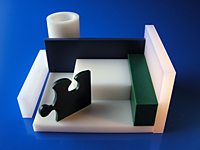
1029 Pulinski Rd Ivyland,
PA 18974
Tel:215-672-5225
Fax:215-672-5582
Email: sales@tridentplastics.com
Website: www.tridentplastics.com
PA 18974
Tel:215-672-5225
Fax:215-672-5582
Email: sales@tridentplastics.com
Website: www.tridentplastics.com

UHMWPE is polyethylene with a molecular weight numbering in the millions, usually between 3.1 and 5.67 million. The high molecular weight results in less efficient packing of the chains into the crystal structure as evidenced by densities less than high density polyethylene (e.g. 0.935 - 0.930). The high molecular weight results in a very tough material. UHMWPE can be made through any catalyst technology, although Ziegler catalysts are most common. UHMWPE is used in high modulus fibers and in bulletproof vests.

| Items |
 2900-0300 Natural UHMW-PE Rod |
 2900-0500 Natural UHMW-PE Rod |
 2900-0700 Natural UHMW-PE Rod |
 2900-0900 Natural UHMW-PE Rod |
 2900-1000 Natural UHMW-PE Rod |
|||||
| Weight | N/A 0.075 lb/ft | N/A 0.113 lb/ft | N/A 0.150 lb/ft | N/A 0.188 lb/ft | N/A 0.225 lb/ft | |||||
| Density (ASTM D792) | N/A 58.01 lb/ft³ | |||||||||
| Hardness - Durometer - Shore D (ASTM D2240) | N/A 68 | |||||||||
| Coefficient of Friction, Static | N/A 0.15 | |||||||||
| Coefficient of Friction, Dynamic | N/A 0.12 | |||||||||
| Tensile Strength at Break (ASTM D638) | N/A 5800 psi | |||||||||
| Tensile Modulus (ASTM D638) | N/A 120000 psi | |||||||||
| Elongation - Yield (ASTM D638) | N/A 15 % | |||||||||
| Tensile Elongation, Break | N/A 250 % | |||||||||
| Flexural Modulus | N/A 110000 psi | |||||||||
| Izod Impact | N/A 34 ft·lb/in | |||||||||
| Tensile Impact Strength (DIN 53448) | N/A 1050 ft·lb/in² | |||||||||
| Coefficient of Linear Thermal Expansion | N/A 11 x 10-5 in/in/ºF | |||||||||
| Maximum Operating Temperature | N/A 180 ºF | |||||||||
| Volume Resistivity (ASTM D257) | N/A > 1015 ohm·cm | |||||||||
| Standard Length | N/A 10 ft5 ft | |||||||||
|
|
||||||||||